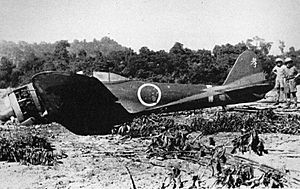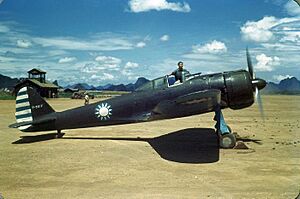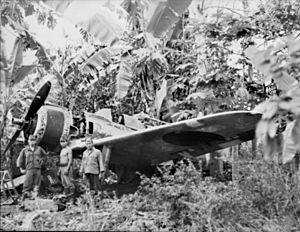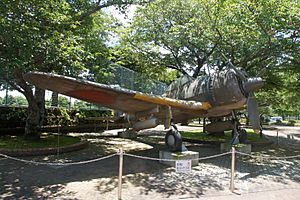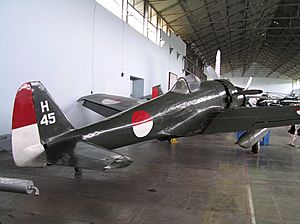Nakajima Ki-43 Hayabusa facts for kids
class="infobox " style="float: right; clear: right; width: 315px; border-spacing: 2px; text-align: left; font-size: 90%;" ! colspan="2" style="text-align: center; font-size: large; padding-bottom: 0.3em;" | Ki-43 "Hayabusa" |-
|- | colspan="2" style="text-align: center;" | 
|-
! Role | Fighter aircraft |- ! National origin | Japan |- ! Manufacturer | Nakajima Aircraft Company |-
! First flight | Early January 1939 |-
! Introduction | October 1941 |- ! Retired
|
- 1945 (Japan)
- 1952 (China)
|-
! Primary users
| Imperial Japanese Army Air Service
- Royal Thai Air Force
- Manchukuo Air Force
- Indonesian Air Force
|- ! Produced | 1939–1945 |- ! Number built | 5,919 |-
|} The Nakajima Ki-43 Hayabusa (meaning "Peregrine falcon" in Japanese) was a single-engine fighter plane. It was used by the Imperial Japanese Army Air Service during World War II.
The Allied forces gave it the nickname "Oscar". American pilots often called it the "Army Zero" because it looked a bit like the Mitsubishi A6M Zero. The Zero was a similar plane used by the Japanese Navy. Both planes had a similar shape and used the same type of engine. This made them look alike, especially during fast air battles.
Like the Zero, the Ki-43 was light and easy to fly. It became famous for its amazing performance in the early years of the war. It could outmaneuver almost any enemy plane. However, it did not have strong armor or special fuel tanks that could seal themselves if hit. Its weapons were also not very powerful until the very last version. Allied pilots found the nimble Ki-43s hard to hit. But once hit, they often caught fire or broke apart easily.
About 5,919 of these planes were built. Many were used in the last months of the war for special kamikaze missions. These were dangerous missions where pilots would crash their planes into enemy ships.
Contents
Designing the Hayabusa: How it was Built
The Ki-43 was designed by Hideo Itokawa. He later became well-known for his work in Japanese rocketry. The first Ki-43 was made in early 1939. It was meant to replace an older plane called the Nakajima Ki-27 Nate. The army wanted a new plane that was faster and could climb higher. It also needed to be as easy to maneuver as the Ki-27.
When the first Ki-43 flew, pilots were not happy. They said it wasn't much faster and was harder to turn than the old Ki-27. To fix this, Nakajima made many changes to the plane. They made it lighter and changed its shape. A big improvement was adding special "butterfly" flaps. These flaps helped the plane make very tight turns. After many tests, the army decided to start building the Ki-43.
The first production model, called the Ki-43-I, started being delivered in 1941. It was very easy to maneuver and could climb quickly because it was so light. It had a top speed of about 495 kilometers per hour (307 mph). The Ki-43-I usually had two machine guns. Some had smaller 7.7 mm guns, while others had a mix of 7.7 mm and larger 12.7 mm guns. Later versions had two 12.7 mm guns for more firepower.
Newer versions, called the Ki-43-II, started flying in 1942. These had a more powerful engine and a three-bladed propeller. The wings were made stronger, and the plane could carry bombs or extra fuel tanks. The Ki-43-II also had a 13 mm armor plate to protect the pilot's head and back. Its fuel tanks were covered in rubber to help them seal if shot. This made the plane safer for the pilot. Production of the Ki-43-II began in late 1942.
The last version, the Ki-43-III, had an even more powerful engine. Its top speed increased to 576 kilometers per hour (358 mph). Production of the Ki-43 continued until the end of the war in 1945. In total, 5,919 Ki-43 aircraft were built.
Hayabusa in Action: Its War Story
The Ki-43 was the most used fighter plane by the Japanese Army. It was flown by many different units. The first Ki-43-I planes started flying missions in China in October 1941. Newer versions joined the fight in 1942, 1943, and 1944. The plane fought in many places, including China, Burma, New Guinea, and the Philippines. It also defended the Japanese home islands.
At the start of the war, the Ki-43 was very successful. It was better than most Allied fighter planes in the region. But as the war went on, the Ki-43 faced stronger enemy aircraft. Planes like the Republic P-47 Thunderbolt and Lockheed P-38 Lightning were faster and had much stronger weapons and armor. The Ki-43's light armor and weak self-sealing fuel tanks became a big problem. Its two machine guns were often not enough against the tougher Allied planes.
As the war turned against Japan, many Ki-43 pilots were less experienced. However, the Ki-43's excellent maneuverability could still surprise careless Allied pilots. Near the end of the war, many Hayabusas were used in kamikaze attacks. These were desperate missions to crash into enemy ships.
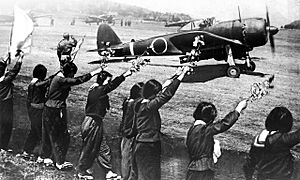
The Ki-43 was also given to other countries that supported Japan. These included Thailand and Manchukuo. Thai Ki-43s sometimes fought against American planes in China.
Japanese pilots really liked the Hayabusa. They found it pleasant to fly and easy to control. Many top Japanese fighter pilots scored victories with the Ki-43. The highest-scoring Hayabusa pilot was Sergeant Satoshi Anabuki, who had 39 confirmed victories.
After the war, some captured Ki-43s were used by other countries. The French Air Force used them for a short time in Indochina. In Indonesia, some abandoned Ki-43s were repaired and used by the new Indonesian government. They fought against Dutch forces trying to regain control.
Different Types of Hayabusa Planes
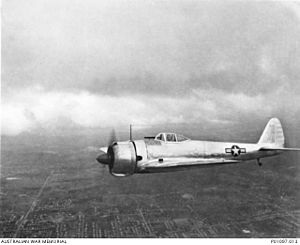
Over time, the Ki-43 was improved and different versions were made:
- Ki-43-I "Ko" (Mark 1a): This was the first production model. It had two 7.7 mm machine guns.
- Ki-43-I "Otsu" (Mark 1b): This version had one 12.7 mm machine gun and one 7.7 mm machine gun.
- Ki-43-I "Hei" (Mark 1c): This model had two 12.7 mm machine guns. It could also carry two small 30 kg bombs under its wings. Older Ki-43-I planes were often updated to this version.
- Ki-43-II "Ko" (Mark 2a): This was the main production model of the Ki-43-II. It had a more powerful engine and stronger wings. It also had self-sealing fuel tanks and pilot armor. It could carry up to 500 kg of bombs.
- Ki-43-II-KAI (Mark 2 improved): This version had improved exhaust pipes that gave it a little more power. It also had an extra fuel tank inside the plane.
- Ki-43-III "Ko" (Mark 3a): This was the final production model. It had an even more powerful engine, which made it faster.
- Ki-43-III "Otsu" (Mark 3b): Only two prototypes of this version were built. It was planned to have two powerful 20 mm cannons.
Who Used the Hayabusa?
During the War
After the War
 China Nationalist Chinese Air Force
China Nationalist Chinese Air Force People's Republic of China Chinese Communist Air Force
People's Republic of China Chinese Communist Air Force France French Air Force
France French Air Force Indonesia Indonesian Air Force
Indonesia Indonesian Air Force North Korea North Korean Air Force
North Korea North Korean Air Force
Where to See a Hayabusa Today
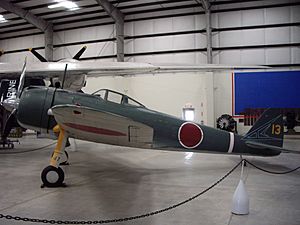
Several Ki-43 aircraft still exist today. You can see them in museums around the world:
- A Ki-43-I is on display at the Flying Heritage Collection in Everett, Washington, USA.
- A Ki-43-II is displayed at the Australian War Museum in Canberra, Australian Capital Territory, Australia.
- A Ki-43-IIb is at the Pima Air & Space Museum in Tucson, Arizona, USA.
- A rebuilt Ki-43-IIIa, made from parts of several planes, is at the Museum of Flight in Seattle, Washington, USA.
- Another rebuilt Ki-43-IIIa is at the Ericson Aircraft Collection in Madras, Oregon, USA.
- A Ki-43 is on display outside the Chiran Peace Museum for Kamikaze Pilots in Minamikyūshū, Kagoshima, Japan.
- A Ki-43 is on display at the Dirgantara Mandala Museum in Yogyakarta, Indonesia.
Hayabusa Facts: What it Could Do
Here are some facts about the Ki-43-IIb model:
- Crew: One pilot
- Length: 8.92 meters (29 feet 3 inches)
- Wingspan: 10.84 meters (35 feet 7 inches)
- Height: 3.27 meters (10 feet 9 inches)
- Engine: One Nakajima Ha-115 radial engine, providing 1,300 horsepower for takeoff.
- Top Speed: 530 kilometers per hour (329 mph) at 4,000 meters (13,120 feet).
- Range: 1,760 kilometers (1,090 miles). It could fly up to 3,200 kilometers (2,000 miles) with extra fuel tanks.
- Ceiling: It could fly as high as 11,200 meters (36,750 feet).
- Climb Rate: It could climb to 5,000 meters (16,400 feet) in just under 6 minutes.
- Weapons:
- Ki-43-Ia: Two 7.7 mm machine guns.
- Ki-43-Ib: One 7.7 mm machine gun and one 12.7 mm machine gun.
- Ki-43-Ic, IIa, IIb, II Kai, and IIIa: Two 12.7 mm machine guns.
- Ki-43-IIIb (prototype): Two 20 mm cannons.
- Bombs:
- Ki-43-I: Could carry two 15 kg bombs.
- Ki-43-II and III: Could carry two 30 kg or two 250 kg bombs.
- All versions could carry two 200 liter (53 US gallon) drop tanks for extra fuel.
|
- Aircraft related to this one
- Nakajima Ki-27
- Nakajima Ki-44
- Nakajima Ki-84
- Similar aircraft
- Bloch MB.152
- Curtiss P-36 Hawk
- Curtiss-Wright CW-21
- Grumman F4F Wildcat
- IAR 80
- Macchi MC.200
- Mitsubishi A6M Zero
- Polikarpov I-180
- Reggiane Re.2000
- Supermarine Spitfire
- Vultee P-66 Vanguard
- Weiss Manfréd WM-23 Ezüst Nyíl
- Lists related to this aircraft
- List of aircraft of Japan during World War II
- List of aircraft of World War II
- List of military aircraft of Japan
See also
 In Spanish: Nakajima Ki-43 para niños
In Spanish: Nakajima Ki-43 para niños



